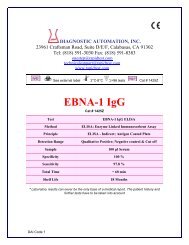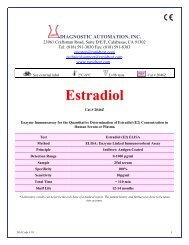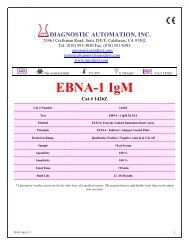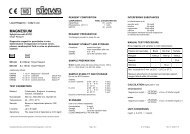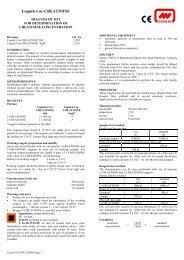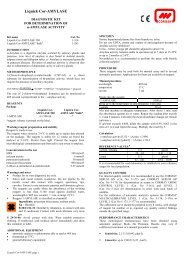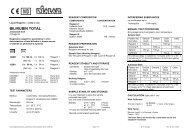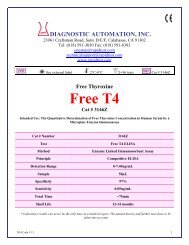Liquick Cor-ALP
Liquick Cor-ALP
Liquick Cor-ALP
You also want an ePaper? Increase the reach of your titles
YUMPU automatically turns print PDFs into web optimized ePapers that Google loves.
<strong>Liquick</strong> <strong>Cor</strong>-<strong>ALP</strong><br />
DIAGNOSTIC KIT<br />
FOR DETERMINATION OF<br />
ALKALINE PHOSPHATASE ACTIVITY<br />
Kit name<br />
Cat. No<br />
<strong>Liquick</strong> <strong>Cor</strong>-<strong>ALP</strong> mini 1-291<br />
<strong>Liquick</strong> <strong>Cor</strong>-<strong>ALP</strong> 30 1-218<br />
<strong>Liquick</strong> <strong>Cor</strong>-<strong>ALP</strong> 60 1-212<br />
INTRODUCTION<br />
Alkaline phosphatase (<strong>ALP</strong>) is actually a group of isoenzymes that<br />
hydrolyse monophosphate esters in alkaline medium. Optimum pH<br />
for these <strong>ALP</strong> isoforms activities is about 9-10. Alkaline phosphatase<br />
level is the highest in liver, bone, intestine, kidney and placenta.<br />
Measurement of <strong>ALP</strong> isoenzymes is useful in diagnosis of these<br />
organs diseases.<br />
METHOD PRINCIPLE<br />
Kinetic method recommended by International Federation of Clinical<br />
Chemistry (IFCC).<br />
2-amino-2-methyl-1-propanol + p-nitrophenylophosphate + H 2 O<br />
4-nitrophenol + 2-amino-2-methyl-1-propanol phosphate<br />
<strong>Liquick</strong> <strong>Cor</strong>-<strong>ALP</strong> page 1<br />
<strong>ALP</strong><br />
The rate of 4-nitrophenol formation is directly proportional to the<br />
<strong>ALP</strong> activity.<br />
REAGENTS<br />
Package<br />
<strong>Liquick</strong> <strong>Cor</strong>-<br />
<strong>ALP</strong> mini<br />
<strong>Liquick</strong> <strong>Cor</strong>-<br />
<strong>ALP</strong> 30<br />
<strong>Liquick</strong> <strong>Cor</strong>-<br />
<strong>ALP</strong> 60<br />
1-<strong>ALP</strong> 2 x 24 ml 5 x 24 ml 5 x 48 ml<br />
2-<strong>ALP</strong> 1 x 12 ml 1 x 30 ml 1 x 60 ml<br />
The reagents when stored at 2-8 C are stable up to expiry date<br />
printed on the package. The reagents are stable for 12 weeks on<br />
board the analyser at 2-10 C. Protect from light and avoid<br />
contamination!<br />
Working reagent preparation and stability<br />
Assay can be performed with use of separate 1-<strong>ALP</strong> and 2-<strong>ALP</strong><br />
reagents or with use of working reagent. For working reagent<br />
preparation mix gently 4 parts of 1-<strong>ALP</strong> with 1 part of 2-<strong>ALP</strong>.<br />
Avoid foaming.<br />
Stability of working reagent:<br />
4 weeks at 2-8 C<br />
5 days at 15-25 C<br />
Protect from light and avoid contamination! Slightly yellow colour of<br />
working reagent is normal and does not influence the result.<br />
Concentrations in the test<br />
2-amino-2-methyl-1-propanol (AMP)<br />
Mg 2+<br />
Zn 2+<br />
HEDTA<br />
p-nitrophenylphosphate<br />
350 mmol/l<br />
2.0 mmol/l<br />
1.0 mmol/l<br />
2.0 mmol/l<br />
16.0 mmol/l<br />
Warnings and notes<br />
• Product for in vitro diagnostic use only.<br />
• The reagents contain sodium azide (< 0.1%) as a preservative.<br />
Avoid contact with skin and mucous membranes.<br />
• During the reaction p-nitrophenol is produced. Do not swallow<br />
or inhale, avoid contact with skin.<br />
• The reagents are usable when the absorbance of the working<br />
reagent is less than 1.250 (read against distilled water,<br />
wavelength λ=405 nm, cuvette l=1 cm, at temp. 25 C).<br />
ADDITIONAL EQUIPMENT<br />
• automatic analyzer or photometer able to read at 405 nm;<br />
• thermostat at 37ºC;<br />
• general laboratory equipment;<br />
SPECIMEN<br />
Serum, heparinized plasma free from hemolysis.<br />
Do not use EDTA, citrate and oxalate as anticoagulants because of<br />
<strong>ALP</strong> activity inhibition!<br />
<strong>ALP</strong> activity remains stable in specimen up to 4 hours at 15-25ºC but<br />
it is recommended to perform the assay with freshly collected<br />
samples. Freezing of sample causes a loss of enzyme activity. Frozen<br />
specimens should be thawed and kept at room temperature for 18 to<br />
24 hours before measurement to achieve full enzyme reactivation.<br />
Nevertheless it is recommended to perform the assay with freshly<br />
collected samples!<br />
PROCEDURE<br />
These reagents may be used both for manual assay (Sample Start and<br />
Reagent Start method) and in several automatic analysers.<br />
Applications for them are available on request.<br />
Manual procedure<br />
wavelength<br />
temperature<br />
cuvette<br />
405 nm<br />
37 C<br />
1 cm<br />
Sample Start method<br />
Pipette into the cuvette:<br />
working reagent 1000 µl<br />
Bring up to the temperature of determination. Then add:<br />
sample 20 µl<br />
Mix and incubate at adequate temperature. After about 1 min. read<br />
the absorbance against air or water. Repeat the reading after exactly<br />
1, 2 and 3 minutes. Calculate the mean absorbance change per minute<br />
( A/min.).<br />
Reagent Start method<br />
The determination can be also performed with use of separate 1-<strong>ALP</strong><br />
and 2-<strong>ALP</strong> reagents.<br />
Pipette into the cuvette:<br />
1-<strong>ALP</strong> 1000 µl<br />
Bring up to the temperature of determination. Then add:<br />
sample 20 µl<br />
Mix well, incubate for 1 min. Then add:<br />
2-<strong>ALP</strong> 250 µl<br />
Mix well; perform measurement as described for Sample Start<br />
method.<br />
Calculation<br />
<strong>ALP</strong> activity [U/l] = A/min. x F<br />
Sample Start method<br />
Reagent Start method<br />
F = 2764 F = 3442<br />
9, 10<br />
REFERENCE VALUES<br />
gender age U/l (37°C) μkat/l (37°C)<br />
1 – 30 days 48 – 406 0.80 – 6.77<br />
31 days – 1 year 124 – 341 2.07 – 5.68<br />
female<br />
1 year – 3 years 108 – 317 1.80 – 5.28<br />
4 – 15 years 54 – 369 0.91 – 6.23<br />
20 – 50 years 42 – 98 0.71 – 1.67<br />
≥ 60 years 53 – 141 0.90 – 2.40<br />
1 – 30 days 75 – 316 1.25 – 5.27<br />
31 days – 1 year 82 – 383 1.37 – 6.38<br />
male<br />
1 year – 3 years 104 – 345 1.73 – 5.75<br />
4 – 15 years 54 – 369 0.91 – 6.23<br />
20 – 50 years 53 – 128 0.90 – 2.18<br />
≥ 60 years 56 – 119 0.95 – 2.02<br />
It is recommended for each laboratory to establish its own reference<br />
ranges for local population.
QUALITY CONTROL<br />
For internal quality control it is recommended to use the CORMAY<br />
SERUM HN (Cat. No 5-172) and CORMAY SERUM HP<br />
(Cat. No 5-173) with each batch of samples.<br />
For the calibration of automatic analysers systems the CORMAY<br />
MULTICALIBRATOR LEVEL 1 (Cat. No 5-174; 5-176) and<br />
LEVEL 2 (Cat. No 5-175; 5-177) is recommended.<br />
The calibration curve should be prepared every 10 days<br />
with change of reagent lot number or as required e.g. quality control<br />
findings outside the specified range.<br />
PERFORMANCE CHARACTERISTICS<br />
These metrological characteristics have been obtained using<br />
automatic analyser Biolis 24i Premium. Results may vary if<br />
a different instrument or a manual procedure is used.<br />
• Sensitivity: 23 U/l (0.38 µkat/l).<br />
• Linearity: up to 750 U/l (12.53 µkat/l).<br />
• Specificity / Interferences<br />
Haemoglobin up to 2.5 g/dl, ascorbate up to 62 mg/l, bilirubin<br />
up to 20 mg/dl and triglycerides up to 1000 mg/dl do not<br />
interfere with the test.<br />
LITERATURE<br />
1. Bessey O.A., Lowry O.H. And Brock M.J.: Biol. Chem.,<br />
164,321,1946.<br />
2. Bowers G.N.Jr. and McComb R.B., Clin. Chem. 12, 70, 1966.<br />
3. McComb R.B. and Bowers G.N.Jr.: Clin. Chem. 18, 97, 1972.<br />
4. Z. Klin. Chem. Klin. Biochem. 8, 658 (1970); 9, 464 (1971); 10,<br />
182 (1972).<br />
5. Kubler W.: Symp. D. Deutschen Ges. fur Lab. Med. Mainz<br />
(1973).<br />
6. Thomas L.: Labor. u. Diag. 1 Aufl., p. 64. Die Med. Verlag,<br />
Marburg (1978).<br />
7. Rick W.: Klinische Chemie und Mikroskopie, p. 294, 6th<br />
edition, Springer Verlag, Berlin (1990).<br />
8. Tietz N.W., Rinker A.D.U., Shaw L.M.: J. Clin. Chem. Clin.<br />
Biochem. 21, 731 (1983).<br />
9. Burtis C.A., Ashwood E.R., ed. Tietz Textbook of Clinical<br />
Chemistry and Molecular Diagnostics 4th ed., PA: WB<br />
Saunders, 2290, 2006.<br />
10. Soldin S. J., Brugnara C., Wong E. C.: Pediatric reference<br />
Ganges, 4th ed, AACC Press, 10-11. (2003).<br />
Date of issue: 07. 2013.<br />
• Precision<br />
Repeatability (run to run)<br />
n = 20<br />
level 1<br />
level 2<br />
Mean<br />
[U/l]<br />
122.47<br />
434.16<br />
SD<br />
[U/l]<br />
3.13<br />
3.93<br />
CV<br />
[%]<br />
2.56<br />
0.90<br />
Reproducibility (day to day)<br />
n = 80<br />
level 1<br />
level 2<br />
Mean<br />
[U/l]<br />
123.18<br />
443.37<br />
SD<br />
[U/l]<br />
7.70<br />
30.25<br />
CV<br />
[%]<br />
6.25<br />
6.82<br />
• Method comparison<br />
A comparison between <strong>ALP</strong> values for samples obtained on<br />
Biolis 24i Premium (y) and obtained on ADVIA 1650 (x) using 100<br />
samples gave following results:<br />
y = 0.8991 x + 5.7629 U/l;<br />
R = 0.9967<br />
(R – correlation coefficient)<br />
WASTE MANAGEMENT<br />
Please refer to local legal requirements.<br />
MANUFACTURER<br />
PZ CORMAY S.A.<br />
22 Wiosenna Street,<br />
05-092 Łomianki, POLAND<br />
tel.: +48 (0) 22 751 79 10<br />
fax: +48 (0) 22 751 79 14<br />
http://www.pzcormay.pl<br />
<strong>Liquick</strong> <strong>Cor</strong>-<strong>ALP</strong> page 2<br />
07/13/07/13






